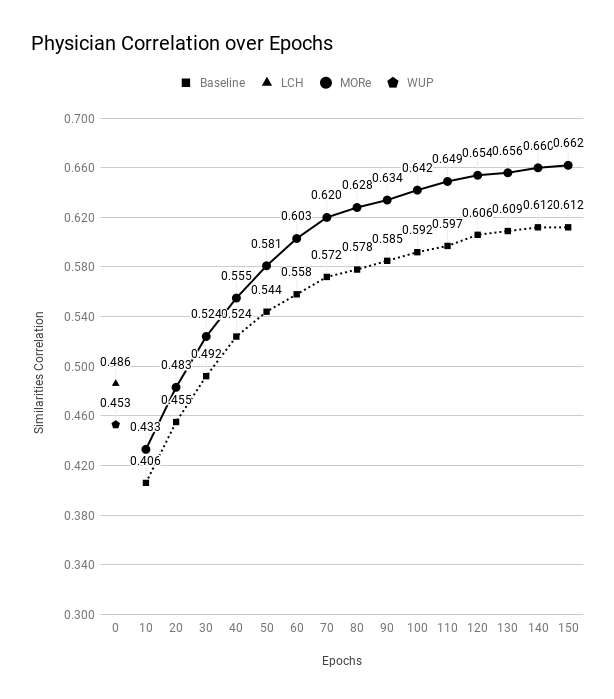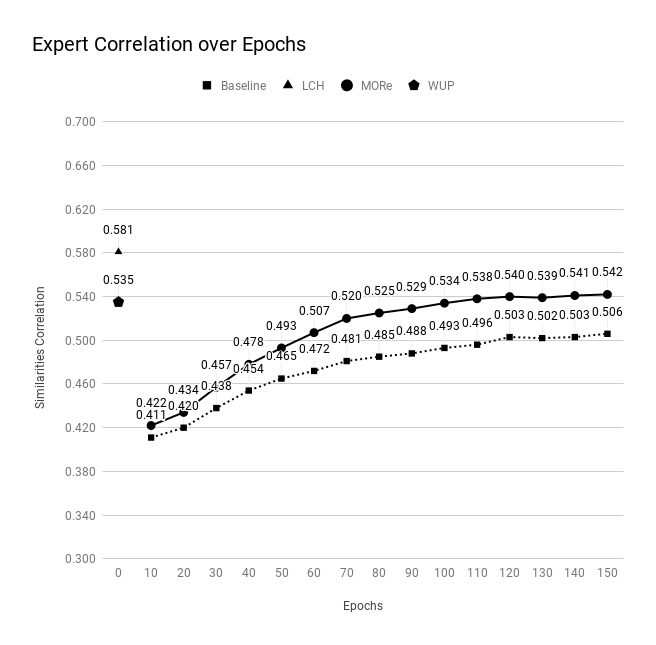Code for the paper "Multi-Ontology Refined Embeddings (MORE): A Hybrid Multi-Ontology and Corpus-based Semantic Representation Model for Biomedical Concepts".
Steven Jiang, Weiyi Wu, Naofumi Tomita, Craig Ganoe, Saeed Hassanpour
RadCore is a large multi-institutional radiology report corpus for NLP. RadCore contains 1,899,482 reports, collected between 1995 and 2006, from three major healthcare organizations: Mayo Clinic (812 reports), MD Anderson Cancer Center (5000 reports), and Medical College of Wisconsin (1,893,670 reports).
Medical Information Mart for Intensive Care (MIMIC-III) is a database containing information gathered from patients that were admitted to critical care units at a large hospital. MIMIC-III also contains a gold standard corpus of 2,434 ICU nursing notes accessible here.
MIMIC-III, a freely accessible critical care database. Johnson AEW,
Pollard TJ, Shen L, Lehman L, Feng M, Ghassemi M, Moody B, Szolovits P,
Celi LA, and Mark RG. Scientific Data (2016). DOI: 10.1038/sdata.2016.35.
Available from: http://www.nature.com/articles/sdata201635
UMLS-Interface is a Perl package that provides an API to a local installation of the UMLS in a MySQL database (available here). UMLS-Similarity is a Perl package that provides an API and a command line program to obtain the semantic similarity between CUIs in the UMLS given a specified set of source(s) and relations (available here). UMLS-Similarity contains five semantic similarity measures proposed by Rada, et. al., Wu & Palmer, Leacock & Chodorow, and Nguyen & Al-Mubaid, and the Path measure.
Installation instructions available here.
McInnes, B. T., Pedersen, T., & Pakhomov, S. V. (2009).
UMLS-Interface and UMLS-Similarity: open source software for measuring paths and semantic similarity.
In AMIA Annual Symposium Proceedings (Vol. 2009, p. 431).
American Medical Informatics Association.
Much of the code in this project is taken from and based off of the official Tensorflow implementation of the word2vec skip-gram model, which available on Github here. The following instructions (copied from the above link) are for compiling the ops:
TF_CFLAGS=( $(python -c 'import tensorflow as tf; print(" ".join(tf.sysconfig.get_compile_flags()))') )
TF_LFLAGS=( $(python -c 'import tensorflow as tf; print(" ".join(tf.sysconfig.get_link_flags()))') )
g++ -std=c++11 -shared word2vec_ops.cc word2vec_kernels.cc -o word2vec_ops.so -fPIC ${TF_CFLAGS[@]} ${TF_LFLAGS[@]} -O2 -D_GLIBCXX_USE_CXX11_ABI=0
On Mac, add -undefined dynamic_lookup to the g++ command. The flag -D_GLIBCXX_USE_CXX11_ABI=0 is included to support newer versions of gcc. However, if you compiled TensorFlow from source using gcc 5 or later, you may need to exclude the flag. Specifically, if you get an error similar to the following: word2vec_ops.so: undefined symbol: _ZN10tensorflow7strings6StrCatERKNS0_8AlphaNumES3_S3_S3_ then you likely need to exclude the flag.
To preprocess the corpora, run the process_file() command in the preprocess.py file. The function returns the cleaned and tokenized text in a list and also prints the output. If no other preprocessing is required, simply cat the output to a .txt file.
To generate the similarity matrices, simply run the umls-similarity.pl script (available here) with the --matrix and --infile configurations, where --infile takes the name of a text file containing one word per line.
python main.py --train_data ./corpus.txt --save_path ./save/ --use_ontologies=False --batch_size=1024 --epochs_to_train=10 --train_model=True > ./log.txt
python main.py --train_data ./corpus.txt --save_path ./save/ --use_ontologies=True --batch_size=1024 --epochs_to_train=10 --learning_rate=0.3 --train_model=True > ./log.txt
In 2007, Pedersen et al. introduced a test set of word pairs for the evaluation of measures of semantic similarity and relatedness in the biomedical domain. The 30 concept pairs of medical terms (See Table 1) were scored by multiple physicians and domain experts on a 4-point scale, according to their relatedness: “practically synonymous (4.0), related (3.0), marginally related (2.0) and unrelated (1.0).” In our study, term pair 5, “Delusion — Schizophrenia”, was excluded from the final evaluation dataset because one of the terms did not appear a minimum of five times in our combined corpora. As a result, the resulting test set consists of 29 of the 30 original pairs. To evaluate the different measures, we calculate the correlation between the similarity scores outputted by the measure and the Physician/Expert similarity scores.
Pedersen, T., Pakhomov, S. V., Patwardhan, S., & Chute, C. G. (2007).
Measures of semantic similarity and relatedness in the biomedical domain.
Journal of biomedical informatics, 40(3), 288-299.
python main.py --train_data ./corpus.txt --save_path ./save/ --train_model=False --use_ontologies=False --eval_ds="./files/eval_ds"
| Physician Similarity Correlation | Expert Similarity Correlation |
|---|---|
 |
 |
MORE is an open-source library and is licensed under the GNU General Public License (v3). If you are using this library please cite:
Steven Jiang, Weiyi Wu, Naofumi Tomita, Craig Ganoe, Saeed Hassanpour, “Multi-Ontology Refined Embeddings (MORE): A Hybrid Multi-Ontology and Corpus-based Se-mantic Representation Model for Biomedical Concepts”, Journal of Biomedical Informatics, 111:103581, 2020.
